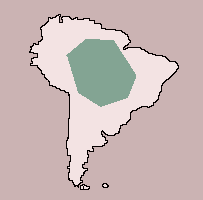South American Lungfish

| Class: Fishes: 4
classes |
Diet: Fish |
| Order:
Lepidosireniformes: African, South American Lungfish |
| Size: 1.2
m (4 ft) |
| Family: No Fish family
information |
Conservation Status:
Non-threatened |
| Scientific Name:
Lepidosiren paradoxa |
Habitat: swamps,
weeded river margins |
| Range:
Central South America |
 The
South American lungfish has a pair of lunglike organs connected with its
esophagus. This fish usually lives in oxygen-poor, swampy areas, but because
of its lungs it is able to supplement the oxygen obtained from the water
by breathing air at the surface. The swamps this lungfish inhabits
are periodically flooded and then undergo a dry season. The fish survives
the dry period by digging itself a burrow in which it lives, breathing
air, while the swamp dries out. Once the surroundings become really arid,
the fish closes the burrow entrance with mud, curls up and covers itself
with a protective covering of mucus secretion to conserve moisture. Its
body slows down to a state of dormancy, but it continues to breathe air.
When the rains return, the lungfish emerges from its burrow. This form
of inactivity in a hot climate is known as estivation. During the
rainy season, lungfish pairs spawn in burrows made by the male. He guards
the eggs and then the young. The newly hatched young have adhesive glands
by which they hang from vegetation and which are lost after 6 to 8 weeks. The
South American lungfish has a pair of lunglike organs connected with its
esophagus. This fish usually lives in oxygen-poor, swampy areas, but because
of its lungs it is able to supplement the oxygen obtained from the water
by breathing air at the surface. The swamps this lungfish inhabits
are periodically flooded and then undergo a dry season. The fish survives
the dry period by digging itself a burrow in which it lives, breathing
air, while the swamp dries out. Once the surroundings become really arid,
the fish closes the burrow entrance with mud, curls up and covers itself
with a protective covering of mucus secretion to conserve moisture. Its
body slows down to a state of dormancy, but it continues to breathe air.
When the rains return, the lungfish emerges from its burrow. This form
of inactivity in a hot climate is known as estivation. During the
rainy season, lungfish pairs spawn in burrows made by the male. He guards
the eggs and then the young. The newly hatched young have adhesive glands
by which they hang from vegetation and which are lost after 6 to 8 weeks.

  
|
